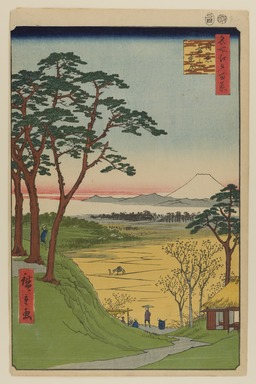
Artist:Utagawa Hiroshige
Medium: Woodblock print
Geograhical Locations:
Dates:4th month of 1857
Dimensions: Sheet: 14 3/16 x 9 1/4 in. (36 x 23.5 cm) Image: 13 3/8 x 8 3/4 in. (34 x 22.2 cm)
Collections:
Exhibitions:
Accession Number: 30.1478.84
Image: 30.1478.84_PS20.jpg,
Catalogue Description: View of the bluff overlooking the Meguro River and Mt. Fuji, halfway between Chiyogaike Pond (seen in print 23 of the series) and the New Fuji (print 24). The path leading down to the river is known today as Chayazaka, Teahouse Slope, and has since been paved. A similar view appears in Hiroshige's "Ehon Edo Miyage" vol. VII, where it is recorded that the third shogun, Iemitsu, was graciously served here by an elderly couple at their small teahouse, which was known thereafter as "Jijigachaya" or Grandpa's Teahouse. There is another version of the story involving the eighth shogun, Yoshimune, as related by Murao Karyo, who visited the location in 1811. In any event, the present plaque erected by Meguro Ward credits both shoguns with visiting the teahouse. Interestingly, Karyo's version tells of two teahouses: one for Grandma and one for Grandpa, with the former located at the top of the hill. A landscape painting of the two teahouses was done by Shiba Kokan, as a preliminary sketch for a copperplate print he made in 1784. It is thought that the Brooklyn Museum's print 84 is a later impression than that of the Hirose collection in the "Ukiyoe Taikei," in which the area below the Tanzawa Range is printed in red, with a gradation into the sky at left. Here, a separate block was cut to print the red bands that appear above the horizon, and the bokashi gradations on the peaks and at the base of Mount Fuji have been eliminated.